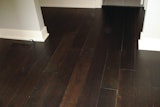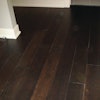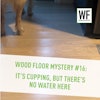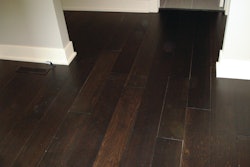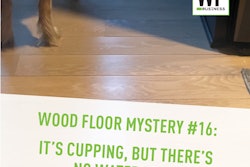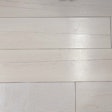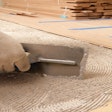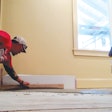
(Editor's Note: This issue introduces our "Customer Education" column. The first page has information for you — the wood flooring professional — and the second — in a clip-and-copy format — is aimed at consumers. We hope you find it useful, and we welcome suggested topics.)
One of the biggest headaches for a wood flooring professional is dealing with customer complaints. If you're like many contractors, many of the complaints you get have to do with moisture-related problems, like cracks between boards, cupping or crowning. You can go a long way in preventing the complaints, however, if you take the proper precautions in installation and educate the customer about what to expect.
To begin, it's important to understand the basics of how wood interacts with moisture. Wood is hygroscopic, meaning that it gains and loses moisture as the relative humidity and temperature of the air around it changes. Depending on humidity, wood will reach an equilibrium moisture content (EMC). As the EMC of the wood flooring decreases, the wood shrinks; as the EMC increases, wood expands.
The effort to minimize moisture problems starts at the manufacturer, where most lumber is dried to a moisture content of 6 to 9 percent before being milled. Until it is installed, the flooring should be stored in an enclosed, well-ventilated building that is clean and dry. The flooring should never be unloaded in wet weather.
At the job site, avoiding moisture problems begins with installing the proper flooring. Solid products should never be installed in rooms that are exposed to excessive moisture, including any room that is below grade — even walk-out basements. (Engineered wood floors are appropriate for below-grade installations.) If drastic humidity changes are expected, species with above-average dimensional stability can be chosen.
Before flooring reaches the job site, the structure should be fully enclosed, with doors and windows in place, and interior climate controls should have been operating for at least 48 hours. Wet trades such as painting and plastering should be completed and dried.
Once the interior is at normal living conditions, wood flooring should be set indoors and spread over the subfloor, with at least four days passing before installation is started. (Manufacturers of engineered flooring products say no such acclimation time is necessary.)
Before work begins, check the moisture content of the concrete slab and/or wood subfloor. For wood subfloors, check several different areas with a moisture meter and average the results. A moisture content of 12 percent or less is considered acceptable in most regions. The level must be within 4 percentage points of the moisture content of the flooring to be installed. For solid plank flooring, the level should be within 2 percentage points.
Several methods are available to test concrete, from concrete-specific moisture meters to physical methods such as calcium chloride tests. Whatever the means of testing, the emission of moisture vapor from the floor should not exceed 3 pounds per 1,000 square feet per 24 hours. Normally concrete should be at least 60 days old to meet this requirement, although flooring can be installed before that if moisture tests indicate that the slab is ready. Always check the wood flooring manufacturers' recommendations for "acceptable moisture content."
Even if subfloors are within an acceptable range, that doesn't mean moisture won't seep from the ground into concrete and subfloors in the future. That's why it is imperative that the installer use a moisture-vapor retarder. If construction is over a concrete slab, a barrier of heavy plastic film should have been laid between the base of gravel or crushed stone and the slab. Before flooring is installed, another barrier or retarder should be laid over the top of the slab. This could be one of a variety of materials — low-end PVC vinyl, polyfilm and 15-pound roofing felt are all used, among others. In joist construction, a vapor retarder of 15-pound saturated felt paper should be laid between the wood subfloor and the wood flooring. If the wood subfloor is laid over a concrete slab, the felt paper can be cemented to smooth, clean-swept concrete.
Whatever the method used, installers should verify the acceptability with the flooring manufacturer. If gluing down over a moisture retarder, they should also check with the adhesive manufacturer for compatibility.
Once installation has begun, it is important that nailing recommendations (available from the National Oak Flooring Manufacturers Association) be followed. With wider flooring, fasteners should be used closer together. Wide planks are often also screwed down to increase stability.
Once the installation is complete and all the necessary precautions have been taken, your best chance of avoiding future problems is customer education. All your painstaking work to prevent moisture problems will go awry if the customer starts damp-mopping the floor once a week. And you'll save yourself a headache in the fall if you let them know that small cracks may appear at that time of year. Just as with the actual installation, it pays to be prepared.
KNOW YOUR WOOD FLOOR
Wood Flooring Expansion and Contraction
Unlike many floor coverings, wood floors can last the lifetime of the building in which they are installed. Home owners who want them to last that long, however, should note the number one enemy of a hardwood floor: moisture. Wood floors naturally expand when moisture is present and shrink when it is not. Whether the reactions are a problem or not depends on the severity of the situation. Following are some of the common results when water and wood floors combine:
CRACKS BETWEEN BOARDS: Almost every wood floor endures some expansion and contraction as seasons and humidity levels change. When homes are heated, humidity levels plummet, boards shrink and spaces appear between the boards. In dry months, cracks can easily develop to the thickness of a dime on a typical solid 2 1/4 -inch oak floor, with light-colored woods making the cracks appear larger. Plank floors also will show cracks more. These spaces are to be expected and usually close up as the season changes and moisture returns to the air. To reduce the degree of change, home owners can add moisture to the air during the dry months, ideally by installing a humidifier in the furnace.

CUPPING: As with cracks between boards, both cupping and crowning are natural reactions to moisture and should not be a concern if they occur only to a minor extent. More severe cases, however, indicate a serious moisture problem.
"Cupping" describes a condition in which the edges of a board are high and its center is lower. Humidity is usually the culprit, although cupping also can happen after water has been spilled onto the floor and absorbed into the wood. The moisture causes the wood to swell, crushing the boards together and deforming them at the edges. In order to repair the floor, the cause of the moisture must be identified. Most often, indoor humidity will have to be controlled. Other causes could include situations such as a plumbing leak in the basement, which can allow moisture to migrate up into the subfloor and the wood flooring.
Once the cause of the moisture is controlled, cupping usually can be reversed. Oftentimes the floor Cupping may naturally dry out and improve over time. Fans may be necessary to speed the drying process. After the floor has dried, it may be necessary to recoat the floor with finish, or to sand and refinish the floor.

CROWNING: "Crowning" is the opposite of cupping: The middle of the board is higher than the edges of the board. This can occur when the surface of the floor encounters moisture. More often, it results when a floor has been sanded too soon after it has cupped. When this happens, the top edges of the board are sanded off, and thus are lower than the rest of the board when it returns to a normal moisture content.
BUCKLING: Buckling is one of the most extreme reactions to moisture that can occur with a hardwood floor. It happens when the floor literally pulls away from the subfloor, up to heights as high as several inches. Fortunately, buckling is an uncommon occurrence, usually happening only after a floor has been flooded. Even in such cases, it is possible that a floor can be repaired instead of being totally replaced.
Preventing Moisture Problems
Controlling humidity is the most important factor in preventing problems with moisture and your wood floor. The correct maintenance also will go a long way in avoiding problems. Among the key points:
• Clean your wood floor with a cloth lightly dampened by a recommended cleaning product, using the manufacturer's directions for use. It is best to buy a "floor care kit" recommended by your wood floor installer or retailer.
• Do not clean your wood floors with water or waterbased products on a regular schedule — clean only when necessary and clean only the soiled areas.
• Never damp mop a wood floor. The water deteriorates the wood and the finish.
• Never let a water spill dry on the floor.
For more information, call the National Wood Flooring Association at 500/443-9663 (WOOD). The cost is $.25/minute.










